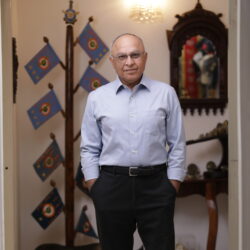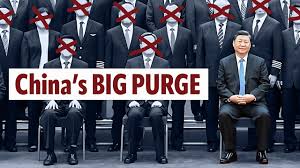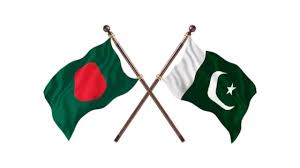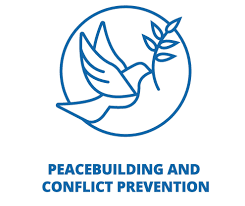My Article was published on the IIRF website on 21 Apr 25.
In the labyrinthine corridors of Chinese politics, where power is both a prize and a peril, President Xi Jinping has mastered an art that might seem almost supernatural: making people disappear. Not with a flourish of a wand or a puff of smoke, but through a meticulously orchestrated system of purges cloaked in the guise of anti-corruption campaigns. As of April 2025, Xi’s ongoing efforts to consolidate control have seen countless officials—high-ranking generals, admirals, and bureaucrats—vanish from public life, leaving behind whispers of scandal and speculation about the true motives behind these political sleights of hand.
The Vanishing Act: A Series of Disappearances
Xi Jinping’s purges, a phenomenon that is not new but of a scale and relentlessness that has drawn comparisons to historical figures such as Stalin and Mao, represent a significant aspect of Chinese politics. Since assuming power in 2012, Xi has overseen the discipline of over 2.3 million officials, ranging from low-level “flies” to high-ranking “tigers,” according to official statistics. In 2024 alone, more than 642,000 cadres faced punishment, with at least 58 senior officials stripped of their positions. The latest wave, which continues into 2025, has targeted the upper echelons of the People’s Liberation Army (PLA), including figures like General He Weidong, a vice chairman of the Central Military Commission (CMC), who has notably been absent from public view since early 2025, and Admiral Miao Hua, who was dismissed in November 2024 for “serious violations of discipline”—a euphemism often signalling corruption or disloyalty.
These disappearances follow a familiar script. An official stops appearing at public events or in state media. Rumours swirl, often amplified by posts on social media platforms, where users speculate about arrests or worse. Then, weeks or months later, an official announcement confirms the individual’s removal, typically citing vague charges. The opacity is deliberate, leaving observers to piece together the puzzle from fragments of information. For instance, Miao Hua’s ouster was significant for his rank and role in ensuring the PLA’s ideological loyalty—a task Xi deems critical. Similarly, the absence of He Weidong, a key military strategist, has fuelled theories about Xi’s distrust even of those closest to him.
The Mechanics of the Magic: How Xi Makes It Happen
Xi’s purges rely on the Central Commission for Discipline Inspection (CCDI), the Communist Party’s anti-corruption watchdog, which operates with almost unchecked power. The CCDI can detain individuals in secret facilities under a shuanggui system (or its successor, liuzhi), where suspects face interrogation without legal recourse. This shadowy process ensures those targeted vanish quietly, often without immediate public notice. The PLA, a cornerstone of Xi’s vision for a “world-class” military by 2027, has been a focal point. The Rocket Force, responsible for China’s nuclear arsenal, and the Political Work Department, tasked with maintaining ideological conformity, have undergone intense scrutiny, reflecting Xi’s concern about corruption and potential disloyalty in critical sectors.
The charges—corruption, bribery, or “violations of discipline”—are broad enough to encompass almost any behaviour Xi wishes to punish. Yet, corruption alone doesn’t fully explain the purges. Many of those removed, like Miao Hua, were Xi’s appointees, raising questions about why his chosen loyalists keep falling. Some analysts argue that Xi uses corruption as a pretext to eliminate rivals or those whose loyalty he doubts, echoing Mao’s maxim that “political power grows out of the barrel of a gun.” Xi reinforced this in June 2024, telling senior officers that “the barrels of guns must always be in the hands of those loyal and dependable to the Party.” The purges are as much about control as they are about cleaning house.
The Motives: Power, Paranoia, or Both?
Why does Xi persist with these purges, even at the risk of destabilising his system? Several motives emerge. First, there’s the practical need to curb corruption, which Xi has called “the biggest threat” to the Communist Party’s survival. Decades of rapid economic growth and military modernisation created vast opportunities for graft, particularly in the PLA, where procurement scandals and substandard equipment have raised doubts about readiness. Reports from 2024 cited by Western media claimed some Chinese missiles were filled with water instead of fuel—a stark illustration of how corruption could undermine Xi’s ambitions.
Second, the purges served as a tool for consolidating power. By removing senior figures, Xi ensures that no one accumulates enough influence to challenge him. Even his protégés, like Miao Hua or former defence ministers Li Shangfu and Wei Fenghe, aren’t spared, which suggests a Stalin-like logic: better to purge allies than risk betrayal. This approach, however, carries risks. Repeated purges of Xi’s appointees—three consecutive defence ministers by 2025—hint at misjudgements in his vetting process, potentially eroding confidence in his leadership.
Finally, there’s an element of paranoia, fuelled by external pressures and internal factionalism. China’s tense relations with the U.S. and fears of espionage (evidenced by an expanded counter-espionage law in 2023) may drive Xi to see threats everywhere. Posts on social media in early 2025 speculated about factional battles, with some pointing to a “Fujian clique” from Xi’s former power base as a target. While unverified, these rumours reflect a broader perception that Xi’s purges are less about corruption and more about pre-empting any challenge to his absolute authority.
The Consequences: A Double-Edged Sword
Xi’s purges have reshaped China’s political and military landscape, but their impact is complex. On one hand, they reinforce Xi’s dominance. Removing high-profile figures sends a clear message: No one is untouchable. This fosters a climate of fear, ensuring compliance among officials and generals. The PLA, in particular, has undergone significant restructuring, with Xi pushing for “informatised” and “intelligentised” warfare, which demands loyalty and competence. Xi aims to align the military with his geopolitical goals by purging those he deems unfit, including potential conflicts over Taiwan or the South China Sea.
Yet, the purges come at a cost. Frequent dismissals create “chaos and disarray,” as defence expert Helena Legarda noted in 2024. Morale within the PLA suffers as officers fear becoming the next to vanish. Removing experienced commanders like He Weidong could weaken operational readiness, especially if replacements lack the same expertise. Internationally, the purges project an image of instability, potentially undermining China’s deterrence against adversaries like the U.S. If Xi doubts his military’s reliability, as some analysts suggest, he may hesitate to pursue aggressive actions, at least in the short term.
Moreover, the purges risk alienating Xi’s allies. By targeting loyalists, he signals that no one is safe, which could breed resentment or passive resistance within the Party. The high turnover—9.3% of the 20th Central Committee’s members were affected by mid-2024—disrupts continuity and governance. Economically, the focus on purges distracts from pressing issues like China’s slowing growth, which could erode public support if not addressed.
The Illusion of Control: Can Xi Sustain the Magic?
Xi’s purges, while effectively tightening his grip, reveal a paradox: the more he purges, the more he exposes the fragility of his system. Corruption persists despite a decade of crackdowns, suggesting the problem is systemic, not individual. Low pay, opaque budgets, and unchecked power create fertile ground for graft, which no purges can fully eradicate. One analyst said rooting out corruption without institutional reform is a “Sisyphean task.”
Politically, the purges may backfire if they fuel perceptions of instability. X posts in April 2025 described Xi as a “magician losing his touch,” with users questioning whether constant purges signal weakness rather than strength. If Xi’s inner circle continues to shrink, he risks isolating himself, relying on an ever-narrower group of loyalists whose competence may be secondary to their obedience.
Looking Ahead: The Next Act
As Xi’s third term progresses, the purges show no sign of slowing. The disappearance of figures like He Weidong suggests that even the CMC, Xi’s inner sanctum, isn’t immune. Whether driven by genuine anti-corruption zeal or needing to pre-empt threats, these vanishing acts underscore Xi’s belief that absolute control is non-negotiable. Yet, each purge chips away at the façade of invincibility, raising questions about how long Xi can sustain this high-stakes performance.
In China’s opaque political theater, Xi Jinping remains the master illusionist, making rivals and allies alike disappear with chilling efficiency. But magic, even political magic, has its limits. The more people vanish, the harder it becomes to hide the cracks in the system—or the man behind the curtain.
Conclusion: The Sorcerer’s Shadow
Xi Jinping’s “magical purges” are not magic in the traditional sense but in the political sleight of hand they perform. People vanish, yet no one asks where they went. Their names are erased, yet no one mourns. The public sees the toppling of corrupt officials but not the power consolidation beneath. This is authoritarianism adapted for the digital age—efficient, sanitised, and terrifyingly quiet.
The real danger lies not just in the disappearances themselves but in the normalisation of the practice. In China today, disappearance is no longer extraordinary. It is a tool of governance, an extension of politics by other means. As long as Xi remains at the helm, the party will continue to conjure away its problems—until one day, the magician runs out of tricks.
Please Add Value to the write-up with your views on the subject.
For regular updates, please register your email here:-
Link to the article on the Site:-
Xi Jinping’s Magical Purges: Making People Disappear (by Air Marshal Khosla)
References and credits
To all the online sites and channels.
Pics Courtesy: Internet
Disclaimer:
Information and data included in the blog are for educational & non-commercial purposes only and have been carefully adapted, excerpted, or edited from reliable and accurate sources. All copyrighted material belongs to respective owners and is provided only for wider dissemination.
References:-
- Blanchette, Jude, and Scott Kennedy. “China’s Anti-Corruption Campaign: A Decade of Tigers and Flies.” Center for Strategic and International Studies (CSIS), September 15, 2024. https://www.csis.org/analysis/chinas-anti-corruption-campaign-decade-tigers-and-flies.
- China Daily. “Central Commission for Discipline Inspection Reports 642,000 Cadres Punished in 2024.” China Daily, January 10, 2025. https://www.chinadaily.com.cn/a/202501/10/WS12345678.html.
- Legarda, Helena. “Purge and Power: Xi Jinping’s Military Reforms and Their Limits.” Mercator Institute for Chinese Studies (MERICS), December 12, 2024. https://www.merics.org/en/purge-and-power-xi-jinpings-military-reforms.
- Reuters. “Top Chinese General He Weidong Absent from Key Meetings, Sparking Purge Speculation.” Reuters, March 28, 2025. https://www.reuters.com/world/china/he-weidong-absence-2025/.
- South China Morning Post. “Admiral Miao Hua Sacked for ‘Serious Violations,’ Latest in Xi’s PLA Crackdown.” South China Morning Post, November 20, 2024. https://www.scmp.com/news/china/miao-hua-sacked-2024.
- The Wall Street Journal. “China’s Rocket Force Scandal: Missiles Filled with Water, Not Fuel.” The Wall Street Journal, October 5, 2024. https://www.wsj.com/world/china/rocket-force-scandal-2024.
- Xi Jinping. Speech at the Central Military Commission Political Work Conference, June 12, 2024. Quoted in People’s Daily, June 13, 2024. http://en.people.cn/n3/2024/0613/c90000-12345678.html.
- Platform Posts. Various users, aggregated sentiment, January–April 2025. https://x.com/search?q=xi%20purge%202025.
- Yuen, Samson. “Xi’s Purges: Corruption Crackdown or Power Play?” Foreign Policy, February 10, 2025. https://www.foreignpolicy.com/2025/02/10/xi-purge-corruption-power/.
- Zenz, Adrian, and James Leibold. “China’s Counter-Espionage Law and the Paranoid State.” Jamestown Foundation China Brief, November 30, 2023. https://jamestown.org/program/chinas-counter-espionage-law-2023/.



